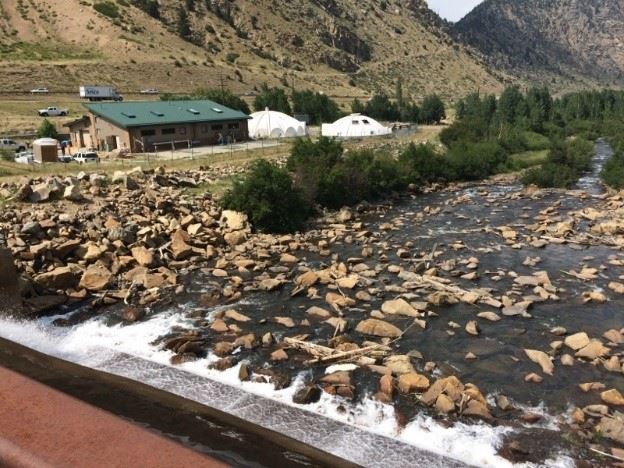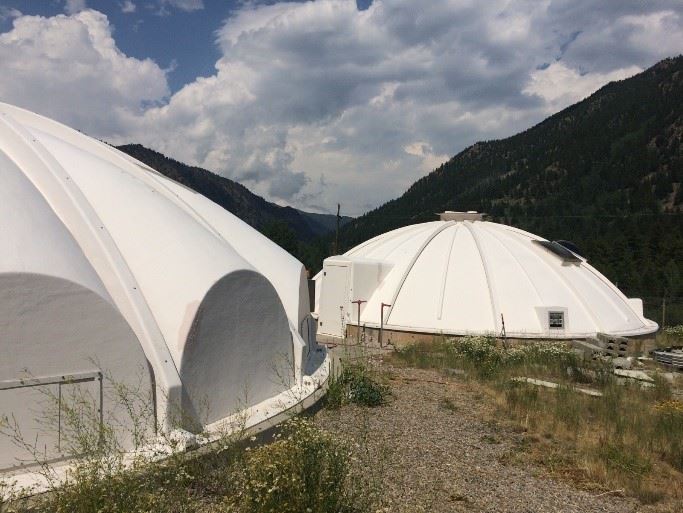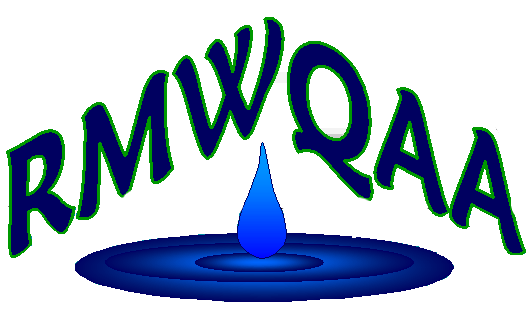On July 27, 2018 about 13 people braved the gorgeous weather and semi-busy Friday afternoon westbound traffic on I-70 to travel to Georgetown on a RMWEA sponsored tour of the Georgetown Wastewater Treatment Plant. Besides the learning opportunity and the chance to be in the mountains, beer after the tour at the local Guanella Pass Brewery was also offered as enticement. No wonder the tour was fully booked!
Friday afternoon westbound traffic on I-70 to travel to Georgetown on a RMWEA sponsored tour of the Georgetown Wastewater Treatment Plant. Besides the learning opportunity and the chance to be in the mountains, beer after the tour at the local Guanella Pass Brewery was also offered as enticement. No wonder the tour was fully booked!
The tour focused on the improvements to nutrient and metal removal technologies that were completed in 2011. These treatment upgrades include an Integrated Fixed-film Activated Sludge system (IFAS) and tertiary polishing of the effluent before chlorination and discharge.
The 2009-2011 Georgetown WWTP upgrades increased the rated flow by 40%, up to 1.2 MGD. The current average flow is between 0.3 MGD and 0.6 MGD. There is still a lot of room to grow, but there is a large new construction project about a mile upstream from the WWTP that is expected to increase flows by 30% when it is complete.
Once entering the plant (by the way, all flows to the Georgetown WWTP are gravity fed-the city does not have a single pump station), the influent is screened and then enters the secondary treatment area (no primary clarification needed!).
 The upgrades included addition of an additional secondary basin with IFAS included for both basins. The attached biomass on the IFAS media (which always looks like tiny plastic pizzelle cookies to me – sorry if you loved pizzelles!) provides increased nitrogen removal (nitrification/denitrification) and some phosphorus removal, while the traditional flocculated activated sludge provides traditional BOD and TSS removal. On the day we were there we were told that both basins were being used, but that the operators go down to one basin during the winter due to reduced flows. The IFAS media takes up about 40% of the volume of each basin, and while the SRT in the basins for the flocculated activated sludge is about 21 days, the media has yet to be replaced after seven years.
The upgrades included addition of an additional secondary basin with IFAS included for both basins. The attached biomass on the IFAS media (which always looks like tiny plastic pizzelle cookies to me – sorry if you loved pizzelles!) provides increased nitrogen removal (nitrification/denitrification) and some phosphorus removal, while the traditional flocculated activated sludge provides traditional BOD and TSS removal. On the day we were there we were told that both basins were being used, but that the operators go down to one basin during the winter due to reduced flows. The IFAS media takes up about 40% of the volume of each basin, and while the SRT in the basins for the flocculated activated sludge is about 21 days, the media has yet to be replaced after seven years.
Effluent from the secondary enters an equalization (EQ) tank. This is the old secondary clarifier that has been modified to be used as an EQ tank. After the EQ tank, the effluent enters the new secondary clarifier, where it remains for “a few hours” before going to the sand filters.

The sand filters are the other main technology that was added during the 2009-2011 upgrade. It is an upflow system with two passes. The upflow system allows the effluent to enter at the bottom of the conical shaped filter area and then flow against the flow of the sand. This technology reduces both phosphorous and metals by 90-95% during each pass.
Georgetown is currently discharging phosphorous at well below their permit limit of 0.3 ppm which equates to greater than 90% removal from their influent phosphorus of 3-4 ppm. Metals such as copper, zinc, cadmium, and lead are also greatly reduced using the sand filters.
After polishing in the sand filters, the effluent enters a traditional chlorine contact basin where it has about 30 minutes contact with chlorine before being dechlorinated with sodium bisulfate before being discharged into Clear Creek right below Georgetown Lake. Georgetown WWTP now uses sodium hypochlorite for disinfection, but they used to make chlorine gas on site!
On the solids side, Georgetown uses a screw press to dewater their solids after digestion. Biosolids are then sent to McDonald farms in Denver, as they do not meet land application requirements. Georgetown is happy to have their own screw press (especially since it works great and can achieve 26% solids), as they used to have to share only a mobile screw press between them, Idaho Springs, and Morrison!
Thanks to the City of Georgetown and RMWEA for the great tour. I was unable to make the beer part of the tour, but I still had a great time and learned a lot!

Richard MacAlpine holds an MS in Environmental Science (WQ Emphasis) from CU-Denver, is on the Education Subcommittee of RMWQAA, and has worked in the lab at Metro Wastewater Reclamation District for the last decade plus.
 Welcome to the
RMWQAA Website!
Welcome to the
RMWQAA Website!  Welcome to the
RMWQAA Website!
Welcome to the
RMWQAA Website!